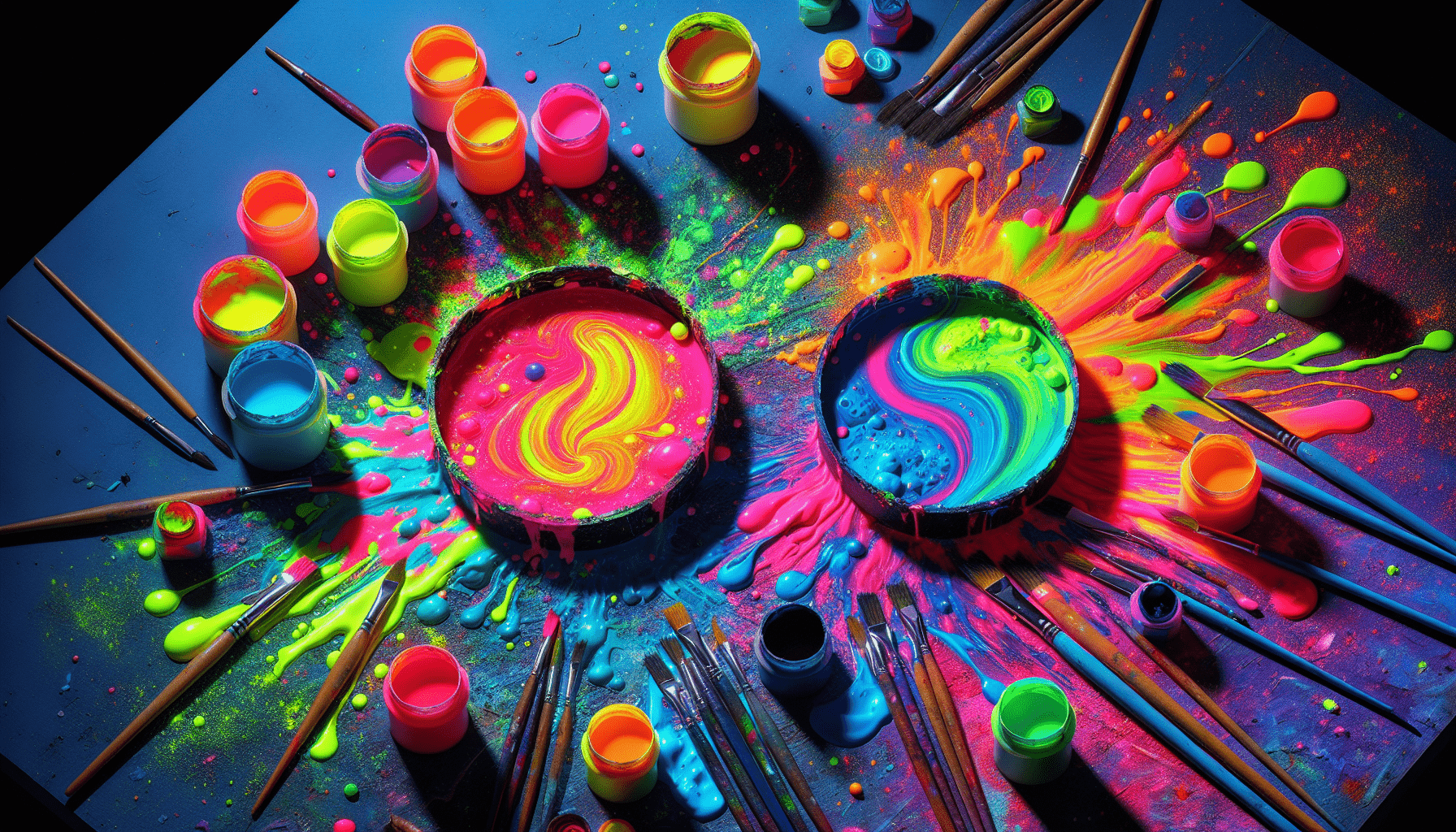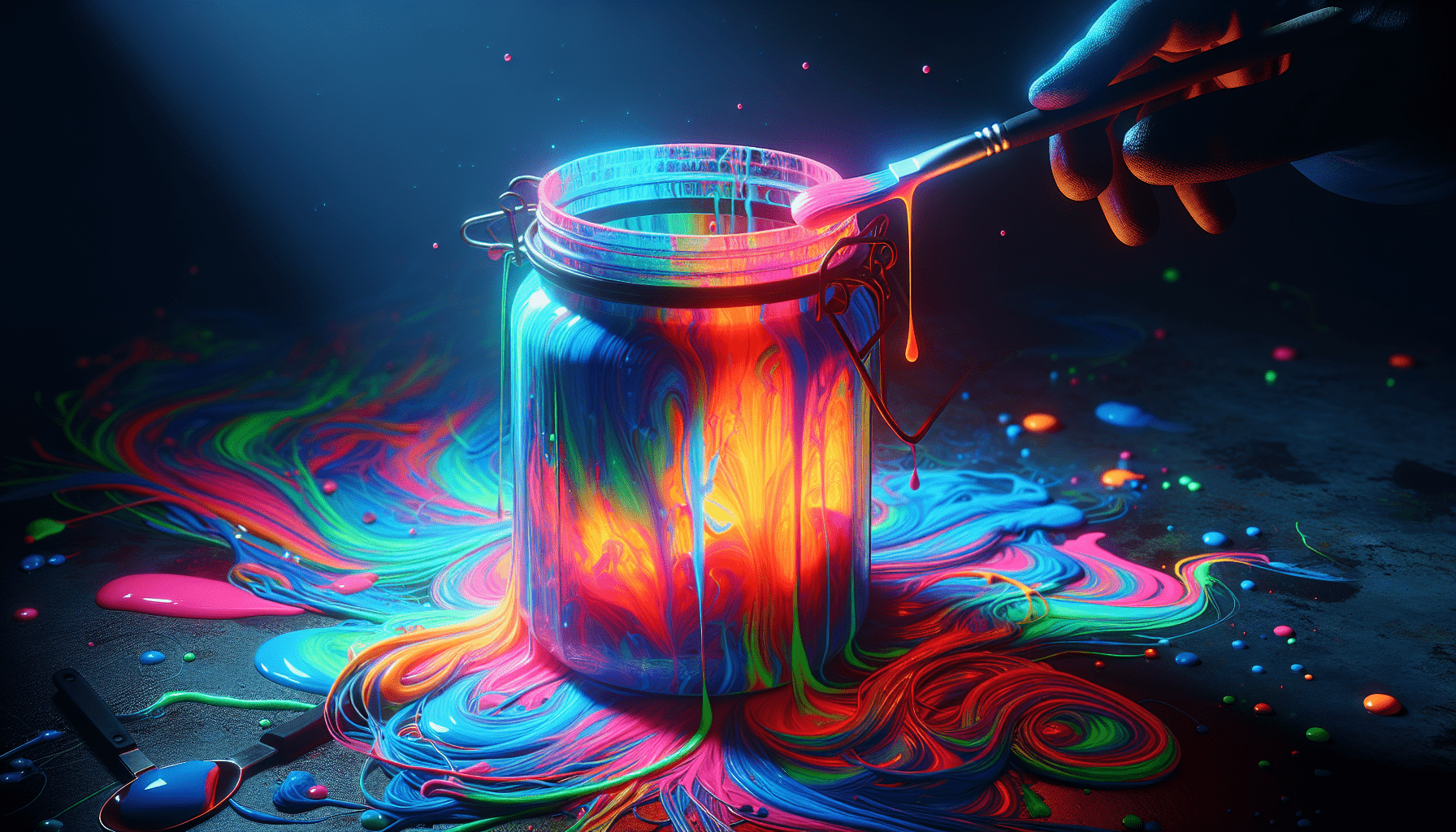Fluorescent paint and neon paint may seem interchangeable at first glance, but despite their vibrant and luminous appearance, they are not synonymous. While both types of paint possess the ability to emit intense, eye-catching colors, the key distinction lies in the light source that activates them. Fluorescent paint glows when exposed to ultraviolet (UV) light, harnessing the energy from the UV spectrum to produce a stunning glow, whereas neon paint utilizes inert gases and electricity to create its distinctive radiance. Understanding the fundamental differences between these two remarkable types of paint is crucial for artists, designers, and enthusiasts seeking the perfect visual effect.

Definition of Fluorescent Paint
Explanation of fluorescent paint
Fluorescent paint refers to a type of paint that exhibits a unique property of glowing when exposed to ultraviolet (UV) light. This glow is achieved due to the presence of fluorescent pigments in the paint, which absorb UV light and re-emit it at a longer wavelength, resulting in a visible glow. Fluorescent paint is widely used in various applications, including safety signs, artworks, textiles, and other innovative designs.
Fluorescent pigment composition
The composition of fluorescent paint primarily consists of fluorescent pigments, which are specially designed to absorb UV light and emit visible light in a distinct and vibrant color range. These pigments, which are typically made up of complex organic compounds, undergo a process called fluorescence, where the absorbed light energy is transformed into visible light. Various fluorescent pigments are available in the market, each offering a different color and intensity.
Characteristics of fluorescent paint
Fluorescent paint possesses several distinct characteristics that differentiate it from conventional paint options. Firstly, it exhibits a significantly higher brightness and vividness in comparison to regular paints. The fluorescent pigments present in the paint result in colors that are exceptionally vibrant, making them highly visible even in low light conditions. Moreover, fluorescent paint is known for its ability to capture attention and create eye-catching effects, making it a popular choice for signage, safety products, and artistic expressions.
Definition of Neon Paint
Explanation of neon paint
Neon paint is a type of paint that shares similarities with fluorescent paint in terms of its luminous quality. However, unlike fluorescent paint, which requires UV light for its glow, neon paint derives its luminosity from an electrically charged gas present inside the paint. When an electrical current is passed through the gas, it emits light, resulting in the distinctive neon glow. Neon paint is widely used in various applications, such as signage, advertising, and establishments with a vibrant nightlife atmosphere.
Neon pigment composition
The composition of neon paint involves the use of noble gases, such as neon, argon, or helium, which are encased in a sealed glass tube. These gases, when ionized by an electrical charge, excite the atoms and produce the characteristic glowing effect. Neon paint is available in a wide range of colors, each attributed to the specific noble gas used.
Characteristics of neon paint
Similar to fluorescent paint, neon paint possesses unique characteristics that set it apart from traditional paint options. Neon paint is known for its intense and vibrant colors, which can be both eye-catching and mesmerizing. The use of noble gases in neon paint allows for the creation of a uniform glow throughout the painted area, providing a striking visual impact. The vibrant and dynamic nature of neon paint makes it a popular choice for signage, enhancing the visibility and attractiveness of advertisements and establishments.
Differences Between Fluorescent Paint and Neon Paint
Source of illumination
One key difference between fluorescent paint and neon paint lies in their respective sources of illumination. Fluorescent paint relies on an external light source, particularly UV light, to trigger the glow of its fluorescent pigments. In contrast, neon paint relies on an electrically charged gas, such as neon or argon, to emit light and create the desired luminosity.
Chemical composition
The chemical composition of fluorescent paint and neon paint also differs significantly. Fluorescent paint contains dyes or pigments that are capable of converting light energy from the UV spectrum into visible light. These pigments undergo fluorescence, emitting a vibrant glow. In contrast, neon paint contains noble gases, such as neon or argon, which are excited by an electrical charge to emit light. The use of different components results in distinct luminous properties for each type of paint.
Color intensity
Another notable difference between fluorescent paint and neon paint is the intensity of the colors they produce. Fluorescent paint is known for its ability to produce bright and vivid colors that stand out in various lighting conditions, including low light environments. The fluorescent pigments present in the paint enable the creation of highly visible and attention-grabbing designs. On the other hand, neon paint produces intense and vibrant colors that possess a unique luminosity. The use of noble gases allows for a strong and captivating glow, enhancing the visual impact of the painted surface.
Application areas
Fluorescent paint and neon paint find their applications in different areas due to their distinct qualities. Fluorescent paint is commonly used in safety signs, artistic creations, textiles, and other designs where high visibility and attention are crucial. The bright and vibrant colors offered by fluorescent paint make it an ideal choice for enhancing safety measures and creating visually impactful artworks. In contrast, neon paint is commonly employed in signage, advertising, and establishments that aim to create a vibrant and energetic atmosphere. The intense and mesmerizing glow provided by neon paint is well-suited for capturing attention and creating an engaging environment.
Source of Illumination
Fluorescent paint uses external light source
The source of illumination for fluorescent paint is external light, particularly ultraviolet (UV) light. When fluorescent paint is exposed to UV light, the fluorescent pigments present in the paint absorb the UV light energy and subsequently emit visible light, resulting in the characteristic glow. This reliance on external light sources makes fluorescent paint dependent on appropriate lighting conditions for its luminosity.
Neon paint uses electrically charged gas
In contrast to fluorescent paint, neon paint derives its illumination from an electrically charged gas, typically noble gases such as neon or argon. Inside the sealed glass tube, an electrical current is passed through the gas, ionizing the atoms and causing them to emit visible light. This self-contained illumination mechanism allows neon paint to emit light independently, making it less reliant on specific lighting conditions.

Chemical Composition
Fluorescent paint contains dyes or pigments that convert light energy
The chemical composition of fluorescent paint primarily consists of dyes or pigments specially formulated to convert light energy from the ultraviolet (UV) spectrum into visible light. These dyes or pigments possess the property of fluorescence, where they absorb higher energy UV light and re-emit the absorbed energy as lower energy visible light. This conversion process results in the characteristic glow of fluorescent paint.
Neon paint contains noble gases that emit light
Neon paint, on the other hand, contains noble gases, such as neon or argon, which emit light when subjected to an electric current. The sealed glass tube in which the noble gases are encased ensures their stability and allows for controlled illumination. When an electrical charge is applied, the atoms of the noble gases become excited and emit visible light. This emission process gives neon paint its luminous quality.
Color Intensity
Fluorescent paint produces brighter and more vivid colors
The color intensity of fluorescent paint is exceptionally bright and vivid. The fluorescent pigments used in the paint are designed to produce vibrant colors that stand out and capture attention. The fluorescent pigments absorb UV light and convert it into visible light, resulting in colors that possess a higher luminosity than traditional paint. This heightened intensity allows fluorescent paint to maintain its visibility even in low light conditions, making it ideal for various applications where visibility is crucial.
Neon paint produces intense and vibrant colors
Similarly, neon paint is renowned for its intense and vibrant colors. The use of noble gases, such as neon or argon, in neon paint creates a distinct luminosity that enhances the vibrancy of the colors. When subjected to an electrical charge, the noble gases emit light, resulting in colors that possess a captivating glow. The intensity of the colors produced by neon paint contributes to its ability to create visually striking designs.
Application Areas
Fluorescent paint is commonly used in safety signs, artworks, and textiles
The unique properties of fluorescent paint make it especially suitable for various application areas. Fluorescent paint is commonly used in safety signs and products, where visibility is critical in low-light situations. The bright and eye-catching colors produced by fluorescent paint enhance the visibility of safety signs, helping to convey important information effectively. Additionally, fluorescent paint is popular in creating artworks and designs, allowing artists to explore vibrant and attention-grabbing visual expressions. The use of fluorescent paint in textiles also enables the creation of unique and vivid designs in the fashion and textile industry.
Neon paint is commonly used in signage, advertising, and nightlife establishments
Neon paint finds extensive application in signage and advertising. The intense and captivating glow offered by neon paint enhances the visual impact of signage, attracting attention and conveying messages effectively. Neon paint is often employed in creating eye-catching displays for retail stores, restaurants, and other businesses. Moreover, neon paint is popular in nightlife establishments, where the vibrant and energetic atmosphere is accentuated through the use of neon lighting and paint. The vivid colors and luminosity of neon paint contribute to the creation of an immersive experience.
Similarities Between Fluorescent Paint and Neon Paint
Both types of paint are known for their brightness
While there are notable differences between fluorescent paint and neon paint, both types of paint share a common characteristic – brightness. Fluorescent paint and neon paint both possess the ability to produce colors that are notably brighter and more vivid than traditional paint options. This brightness allows both types of paint to create visually striking designs that capture attention and stand out.
Both types of paint can be used to create eye-catching designs
Another similarity between fluorescent paint and neon paint is their potential to create eye-catching designs. The distinct luminosity provided by both types of paint allows for the creation of visually engaging and attention-grabbing patterns, signs, and artworks. Whether it is the transformative glow of fluorescent paint under UV light or the captivating radiance of neon paint, both options offer artists, designers, and advertisers the tools to create visually impactful designs.
Popularity and Trends
Growing popularity of fluorescent paint in recent years
In recent years, fluorescent paint has witnessed a surge in popularity due to its unique characteristics and applications. The vibrant colors and increased visibility offered by fluorescent paint have made it increasingly sought after in various industries. The use of fluorescent paint in safety signage, artistic expressions, and fashion has gained prominence, as it allows for enhanced visibility and the creation of visually stunning designs. The growing demand for fluorescent paint is a testament to its effectiveness and versatility.
Long-standing popularity of neon paint in various industries
In contrast, neon paint has maintained its popularity over the years, serving as a staple in various industries. The mesmerizing and dynamic glow provided by neon paint has remained a preferred choice for signage and advertising, as it effectively catches the viewer’s attention. Neon paint continues to be highly sought after in industries that thrive on creating a vibrant and lively atmosphere, such as nightlife establishments and entertainment venues. The enduring popularity of neon paint showcases its timeless appeal and effectiveness in creating visually engaging displays.
Conclusion
In conclusion, while fluorescent paint and neon paint share some similarities in terms of their brightness and ability to create eye-catching designs, they are distinct in terms of their source of illumination, chemical composition, color intensity, and application areas. Fluorescent paint relies on an external light source, contains fluorescent pigments, produces brighter colors, and finds applications in safety signs, artworks, and textiles. On the other hand, neon paint derives its illumination from electrically charged noble gases, contains noble gases, produces intense colors, and is commonly used in signage, advertising, and nightlife establishments. Both types of paint offer unique qualities and applications, and their distinct properties contribute to their popularity and versatility in various industries.



